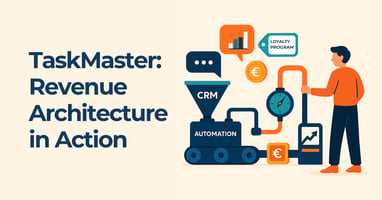Introduction Are you running a startup or a small business? If you often wonder about this...
How to Successfully Run a Small Business. And Avoid the 90% Failure Rate [+ Free Resources]
The Ultimate Survival Guide for IT Startups
Introduction
Running a small business can be exciting, but it often feels overwhelming. Are you dealing with money problems? Marketing that doesn't work? Or a team that seems stretched too thin? You’re not alone.
Many businesses face these challenges. The good news is that you can overcome them. And that's our main goal for writing this comprehensive guide. To give you the knowledge and tools for it.
In fact, while it’s often said that 90% of startups fail within the first 5 years, we are here to help you beat the odds. We’ll help you identify the symptoms of struggling businesses. We'll help you understand the root causes of those signs of trouble. Last but not least, we'll provide actionable solutions to help you succeed.
First, let's understand some basics...
What is a Startup, and When Do You Stop Being One?
Startups are typically defined as young businesses looking to grow quickly and disrupt markets. Many refer to them as small businesses. But is this completely true? Is a startup simply a small business?
The answer to these questions isn’t straightforward. Startups and Small Businesses are, by definition, two different things. But they do share many common characteristics.
We wrote an article covering a lot of aspects involving organizations. This information is relevant to understand which stage your business is in. And what is the natural growth it should follow. Knowing the key aspects of startups, scaleups and grownups, for example, can give you an idea about what to prioritise first and what comes next.
Head over to our blog post What is a Startup, and When do You Stop Being One? to understand more.

Why Your Small Business Feels Stuck: Symptoms, Causes, and How to Fix Them
Now that we have gone over the basics of business definitions, and growth models, it’s time to discuss the most controversial topics. The ones no one actually wants to talk about. The ones that keep you up at night in search for the holy grail solution that will help you be successful.
While running a business can be an amazing experience, it’s certainly due to give you many, many headaches. This is not uncommon. Let’s not forget about the 90% fail rate mentioned at the beginning of this article.
In fact, here is a study by Gary Yamamura from Keiretsu Forum. According to him, of the 90% of failing startups, 10% of those tend to go bankrupt in the first year since being founded. The remaining 80% lose the battle over the next 4 years.
Overall, we have established 3 different types of issues that can go wrong in your business. These are Operational Symptoms, Financial Symptoms and Growth Symptoms. Let's dive into each of these types.
- Operational Symptoms. Do you suffer from poor team alignment? Inefficient processes? Low employee productivity? Or even leadership challenges? This could be telling you to evaluate your operations. And how they are serving your team and the organization.
- Financial Symptoms. Are you experiencing cashflow issues? A lack of funding? Or the inability to generate enough revenue? It’s important then to review your finances. Maybe you need to do proper cost management that tells you whether you’re overspending or not. Maybe you need to seek alternatives to reduce costs.
- Growth Symptoms. Do you suffer from lack of sales or low customer retention? It could evidence a poor product market fit. Or not having a clearly defined target market. Or even the need for a solid business plan.
Check the supporting article that dives deep into these challenges. Or continue reading for a summary of the symptoms, causes and remedies.
The Symptoms: Warning Signs Holding Your Small Business Back
Recognizing the symptoms of a struggling business is the first step toward resolution. Doing so in time, it’s crucial for survival. Having said that, do any of these bulletpoints sound familiar to you?
- My business isn’t growing. Sales have plateaued, or growth feels stagnant.
- I’m constantly running out of money. The leader is scrambling to cover expenses.
- My customers don’t stay for too long. Customers aren’t coming back, impacting long-term revenue.
- I believe my team is experiencing burnout. Overwork and low morale are taking a toll.
- I’m not sure what to prioritise anymore. You’re not sure where to focus your efforts for maximum impact.
- Marketing campaigns aren’t working. Investments in ads or social media bring disappointing results.
This is a short list of the multiple symptoms you could be noticing.
Read our blog post for a deeper analysis on these symptoms.
The Underlying Causes: Reasons Why Your Small Business Might Be Failing
Once you recognize these troubling signs, it’s time to identify the causes behind it. Common reasons include:
- Idea not validated. Your product or service doesn’t meet customer needs.
- No CRM implementation. Without a proper system, managing leads and customer relationships becomes chaotic.
- Focus on tactics over strategy. Day-to-day tasks get more attention than long-term planning.
- Poor money management and planning. Budgets aren’t optimized, and forecasting is neglected.
- Lack of customer focus. You’re not listening enough to customer needs or feedback.
- Weak leadership. Ineffective decision-making and communication that keep slowing progress within your company.
This is a short list of the multiple causes your business could be showing.
Discover more reasons in this supporting blog post.

The Remedies: Solutions for Success
Addressing the challenges start with the right solutions. Here are some ideas that explain how to turn things around:
- Strategic planning. Define clear goals and align your efforts with a long-term vision.
- CRM tools. Implement systems like HubSpot to streamline customer management.
- Workflow automation. Automate repetitive tasks to boost efficiency and free up time for strategic work.
Wanna know more? Our article on this subject, covers all the different remedies that can save your startup.
Building a Strong Foundation for Growth
Long-term growth doesn't just happen. It's planned and built through clear strategies and solid systems. This is where Revenue Architecture comes into play.
Have you ever heard of this term? Do you fully understand what it means?
We have written a whole article covering everything that has to do with Revenue Architecture. From its origins to the steps for building your own system. And let's not forget also about the most common and successful frameworks that support your strategy.
Take a look at this article here or continue reading for a walkthrough of some key aspects.
Revenue Architecture: Designing Your Blueprint (A Step-by-Step Guide)
Designing the growth blueprint for your business requires a structured process. Here’s a step-by-step guide:
- Define Your Ideal Customer. Understand who benefits most from your product and focus your marketing efforts there.
- Create a Clear Sales Process. Simplify the buying journey so customers can purchase easily and quickly.
- Implement CRM and Automation. Use CRM tools like HubSpot to manage customer relationships and automate routine tasks.
- Align Sales and Marketing. Ensure these teams communicate effectively to improve results and customer experience.
- Prioritize Customer Retention. Develop loyalty programs, offer excellent service, and regularly engage your customers.
- Measure and Improve. Track important metrics such as customer satisfaction, conversion rates, and churn rates. Use these insights to continuously improve your strategies.
Learn more about building a foundation for growth here: steps and frameworks.
See It in Action: TaskMaster’s Revenue Architecture Journey
Understanding frameworks is one thing, seeing them applied is another. That’s why we created TaskMaster, a fictional software company, to bring Revenue Architecture to life.
In this easy-to-follow story, you’ll see how a small business goes from chaos to clarity using the very principles we outlined in this guide. From defining their ideal customer to fixing team alignment, automating finances, and improving customer retention. It’s all there!
Whether you’re struggling with growth, team efficiency, or finances, this example breaks down how to put the theory into practice.
Read the full TaskMaster story here.
Conclusion
Recognizing symptoms early is crucial. But so is addressing them with the right strategies. This can set your small business or startup on the path to long-term success. Ready to take the next step?
Next Steps:
If you’re ready to take action, here are three great options!
- Explore all the supporting articles throughout this guide -
- Share your thoughts in the comments: Is there anything else regarding startups and small businesses that you would like to learn about?
- Get your free business mini audit now! A personalized review of your business and a plan with steps to improve.




